AZoBuild talks to Alex Anderson from the University of Washington about the history of Brutalism and its significance now.
Could you please introduce yourself and tell us about your background within architecture?
I’m a member of the Architecture faculty at the University of Washington in Seattle, where I’ve taught for over 20 years.
Most of my research and teaching focus on architectural history and theory, particularly modernism. I’m especially interested in how small-scale design—interiors, surfaces, materials, ornament—affect people’s perceptions of architecture. I also direct our Ph.D. program in the Built Environment, a broadly inclusive program that includes faculty and students from architecture, landscape architecture, construction management, real estate, and urban design and planning.
As an undergraduate student, I studied civil engineering, with an emphasis on building structures, at Cornell University, so my background is quite technical. During my graduate studies in architecture at University of Pennsylvania, my interests moved more to the human side of buildings.
In particular, I asked over and over what role the non-visual senses play in our understanding of architecture. How can architects explore the sounds, textures, and smells of architecture more deeply and more meaningfully? For my Ph.D. dissertation, I framed this question historically, focusing on a small group of modernist French designers who had begun to consider these sensory aspects of architecture in the 1920s, especially in the design of house interiors.
How did the word Brutalism and the movement that followed it come about? What inspired the structures that now litter the UK, Europe, and the US in particular?
Let’s start with the word. The origin of the term “Brutalism,” as applied to architecture, is complex. In his book describing the movement, The New Brutalism: Ethic or Aesthetic, the British architectural historian Reyner Banham goes into a lengthy account of its beginnings, which are fascinating, but I think the story of the term “Brutalism” can be summed up as arising from a joke and a mistranslation.
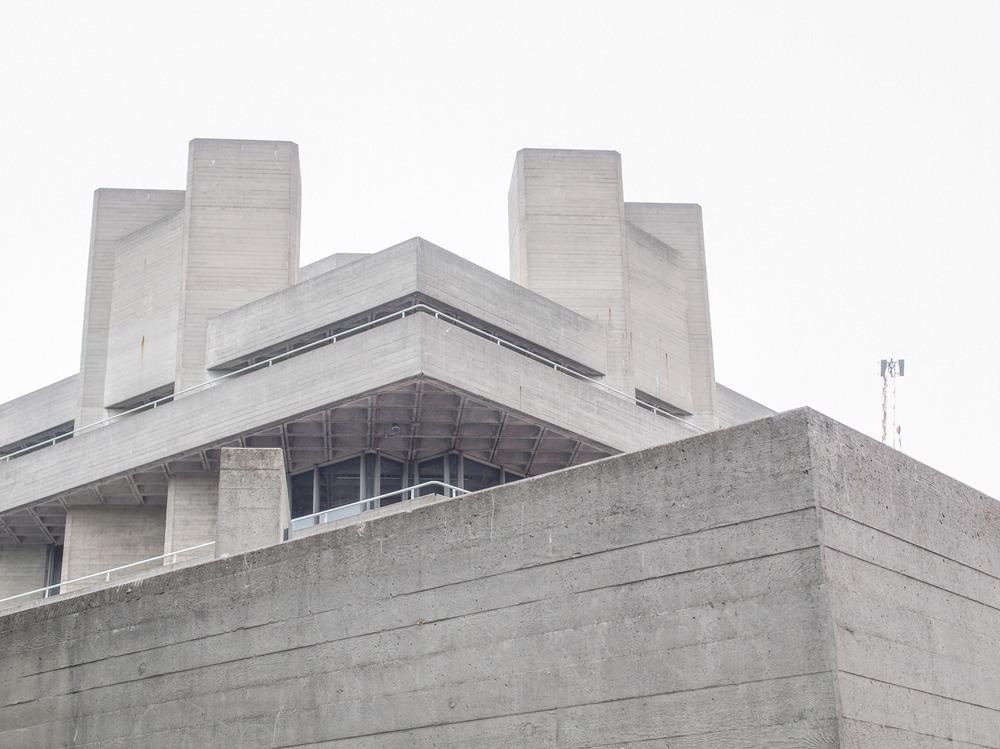
The National Theatre, London. Image Credit: Claudio Divizia/Shutterstock.com
The joke began with a mocking attempt to use an old art-historical trick to label a new artistic movement: find some pithy descriptive word, then add “neo-” or “The New” at the beginning and “ism” at the end, and you have the name of a style. Think “neo-gothicisim” or “The New Romanticism.” By the early 1950s, when Brutalism emerged, modernism had begun to branch in many directions. For example, some architects, especially in Scandinavia, were trying to soften its edges and make it more habitable; critics labeled this kind of work “The New Humanism.”
Other architects, especially a small group in France and England, chose to amplify the more practical developments in architecture, especially its new materials, structures and systems. According to Banham, at least one architectural critic facetiously and somewhat unkindly, labeled this work “The New Brutalism.”
Such labels don’t generally stick unless other factors come into play. This is where the mistranslation comes in. The English term “brutal,” meaning “savagely violent” is neither very descriptive of nor very fair to the work of these architects. However, the French word “brut,” which means “raw” fits quite well. Banham points out that the most important aspect of the movement, its “one undisputed fact,” was the exposed concrete of Le Corbusier’s 1952 housing block in Marseille. In French, “exposed concrete” is “béton brut,” and that apt description of an often-used material is what made the term “Brutalism” stick to a particular version of modernist architecture.
A label and a movement are, of course, two very different things. Often the two don’t fit very comfortably together. The most strict adherents to The New Brutalism, the British architects Alison and Peter Smithson, objected to the label, but more because of its stylistic implications than its violent undertones.
They, like other modernist architects, worked hard to shed the stylistic tendencies of the past in order to make architecture that wasn’t so driven by purely visual characteristics. The Smithsons famously protested that their work represented “an ethic, not an aesthetic.” That ethic involved a particular kind of architectural “truth-telling” that included much more than exposed concrete. Their 1954 Hunstanton School in Norwich, Norfolk, England, offers a great example of how this idea worked.
The building actually used very little concrete; its primary materials are steel, brick, and glass. Everywhere, the roles of these materials are very evident: steel holds the building up, brick and glass enclose it. Similarly, it is easy to understand how its building services like lighting, heating, water supply, and drainage work, because the pipes and conduits are generally exposed. The sinks in the bathroom even drain into an open channel in the floor, to make the water flowing out of the building visible!
Could you describe some of the features that might characterize a traditionally Brutalist building?
While exposed concrete is the most obvious feature of what we call Brutalist architecture, “truth-telling” is its most important attribute. Concrete works in this regard not just because it is left exposed, but also because it reveals its make-up and construction.
Looking closely, it is possible to see the mixture of cement and aggregate that constitutes the material. Concrete surfaces also reveal impressions from the temporary structures used to form it, and patterns of circular dots show where ties held the two sides of the formwork together.
Structural steel and brick cladding can tell similar stories, although with fewer nuances, and in most buildings steel has to be covered for fire safety. When a Brutalist building requires interior claddings—to improve acoustics or thermal performance, for example—gaps often separate these materials from the building structure or exterior enclosure, so their practical purposes are evident.
Finally, brutalist buildings also reveal their inner workings—exposing ducts, pipes, conduits, and mechanical equipment.
When they were first built, these buildings embodied ambition; in your opinion, what caused the shift in public opinion from seeing these structures as impressive feats of architecture to ugly or ‘outcast’ buildings?
In an odd way, the confusion over the term “Brutalism” has contributed to the attention these buildings receive. After all, a somewhat morbid fascination with their supposed brutality makes people curious. Popular journalism plays up the term, and critics of modernism, particularly this version of it, often use the negative associations to amplify their complaints.
These bold buildings elicit fierce detractors. Supporters then counter with equal passion. The result is a class of buildings that are surprisingly newsworthy simply because of the label.
There are more serious and subtle reasons for the people’s opinions about Brutalist buildings. As an “ethical” or “truthful” kind of architecture, it can be very appealing. On a basic level, it can be reassuring to look at a building and understand how it works, or on closer inspection to tease out the story of the building’s construction.
However, many Brutalist buildings became overwrought. Their forms are exaggerated and aggressive; they use too much concrete; they focus too much on building equipment. Sometimes this comes very much at the expense of more traditional values in architecture, like comfort and beauty.
This can be particularly troublesome in Brutalist public or institutional buildings, of which there are many, many examples. Their exterior appearance can seem overbearing and unfriendly, and the abundance of unfinished materials can feel cold or harsh.
Tastes change, though, and Brutalism has enjoyed increasing popularity lately. While many Brutalist buildings have been destroyed over the last couple of decades, recently, important examples have been preserved and restored.
Brutalist architecture relies heavily on concrete as its primary material and façade. Why was this, and why are such large amounts of concrete not utilized in the same way now?
Because of its malleability as a material, concrete can be very expressive. Its mass exhibits sculptural qualities; its surfaces play with light in interesting ways; it reveals its construction more effectively than most other materials, and it doesn’t need finishes to protect it from the weather.
All of these make it a preferred material for a “truth-telling” architecture. But concrete also presents significant problems as a building material. First of all, its exterior appearance belies its interior make-up. Anyone who has seen concrete under construction knows that it contains a lot of steel completely hidden within in it; it isn’t truthful at all about this crucial component!
More practically, concrete is expensive. Constructing a building with concrete essentially requires building it twice: first with the formwork, then with the material itself (and all of the steel hidden inside it). The Portland cement used as the binder in concrete requires huge amounts of energy to produce, which adds to its cost and its environmental footprint. And, over the longer term, buildings constructed primarily with concrete can be difficult to adapt to new purposes. So, as we try to make buildings more efficient, environmentally sound, and sustainable, concrete is often not the best choice.
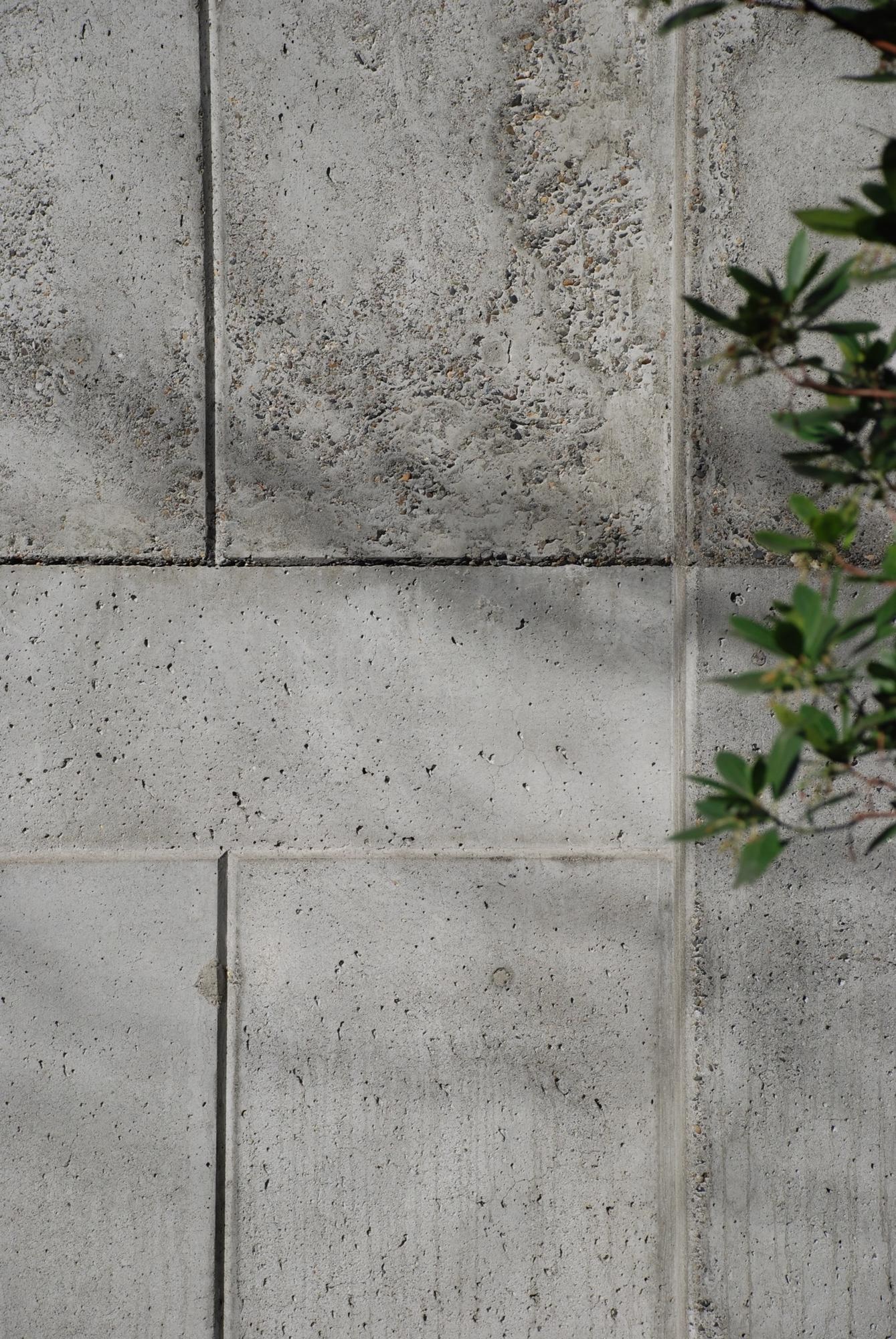
Image Credit: Alex Anderson
In Britain, there is only approximately one hundred ‘world-quality’ Brutalist buildings left. You have defended Brutalist architecture in an essay for the Harvard Graduate School of Design; what is the cultural and historical benefit of the conservation of these remaining structures?
There are many good reasons to conserve existing buildings. Once a building is built, it is usually more environmentally advantageous to preserve and renovate it, rather than to tear it down and replace it. This is particularly true of large concrete buildings, which are not just costly to tear down, they also sequester quite a bit of carbon.
Those are largely practical reasons. We should also value buildings for what they represent about the times in which they were built. Brutalist buildings certainly recall some of the tastes of the 1950s through the 1970s, when they were most popular. It was a taste that seems to have had global appeal, at least for a while.
Aesthetically, then, high-quality Brutalist buildings represent a style that is an important part of 20th-century artistic culture that is worth preserving. Many examples of Brutalist buildings, however, do recall serious insensitivities to the needs of people and to the urban contexts into which they were built, and their preservation should be the subject of careful democratic debate.
People’s negative feelings about these buildings may outweigh the aesthetic or environmental justifications for preserving them.
There has been much recent research into the emissions of CO2 associated with the disposal of concrete in buildings; what are some of the ways we can reuse or regenerate Brutalist structures rather than demolishing them?
The recently popularized adage, “the greenest building is the one that is already built,” certainly holds true for the “concrete behemoths” of Brutalism. Adapting and reusing a building is almost always better environmentally than destroying it.
It seems to me that the “ethical” orientation of Brutalist buildings makes them particularly suited to this understanding of adaptive reuse, even if their heavy use of concrete makes this difficult. However, just as many modernist additions to older buildings offered interesting contrasts in material, construction techniques, and spatial configuration, Brutalist buildings can, and often should be subject to similar alteration.
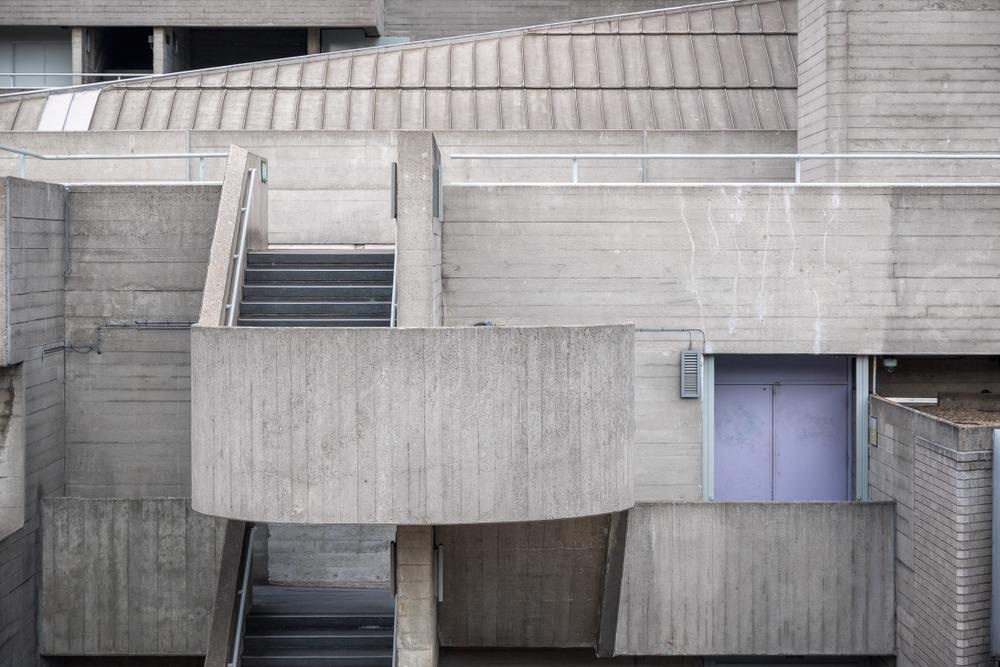
Image Credit: I Wei Huang/Shutterstock.com
Selective cutting and removal of concrete, for example, can enhance the original “truth” of the building by revealing the hidden steel reinforcement; over-structured concrete walls can be made to serve more practical ends; new services can be run along old exposed ductwork and piping; etc. While strict preservation might not be the goal, new additions can resonate with the ethical intentions of the original.
New studies and materials are emerging that feature hybrid materials or ambitions for carbon-neutral concrete; do you think there is any capacity in the future for a return to Brutalist design?
Brutalism was very much a product of its era in the mid to late 20th century. It produced some great buildings and some not-so-great ones. We should certainly hold on to the best products of that era, but I don’t see a need to revive it. There is great value, though, in placing the ethical motivation behind architecture over aesthetic appearances, as the first architects of The New Brutalism did.
New materials and ambitions should lead to new architectural solutions, not a recapitulation of old styles. I hope that future buildings will share an ethical kinship with the best products of Brutalist design, but I don’t hope for a Brutalist revival.
There has been a significant shift in architecture towards biophilic design and green buildings; do these new models further outdate Brutalist architecture, or do you think an intersection could be formed through regeneration efforts?
One of the things I enjoy about exterior concrete is its ability to acquire a patina of rain streaks and moss. Often these are power-washed away, but when preserving and adapting Brutalist buildings, these effects could be more carefully considered and controlled. Raw concrete or masonry surfaces can take on a geological character, making room for biological growth over time.
This possibility has emerged especially in the greening of large-scale infrastructure projects. Highway overpasses carry entire forests, flanking sound walls cast with deep sculptural relief support an abundance of climbing plants, old railway lines become linear parks, massive sea walls, jetties, and piers function as artificial reefs.
Brutalist concrete buildings present different challenges and opportunities, but their heavy masses are well suited to support life, if we encourage it to thrive there.
Do you have a personal favorite Brutalist structure? What makes it so significant to you, if so?
My favorite Brutalist building, Gould Hall in Seattle (1971), is one that its architects protested was never intended to be Brutalist at all. Although it is almost entirely raw concrete, its original designs called for exterior brick cladding. Budget cuts did away with that and other niceties in the design.
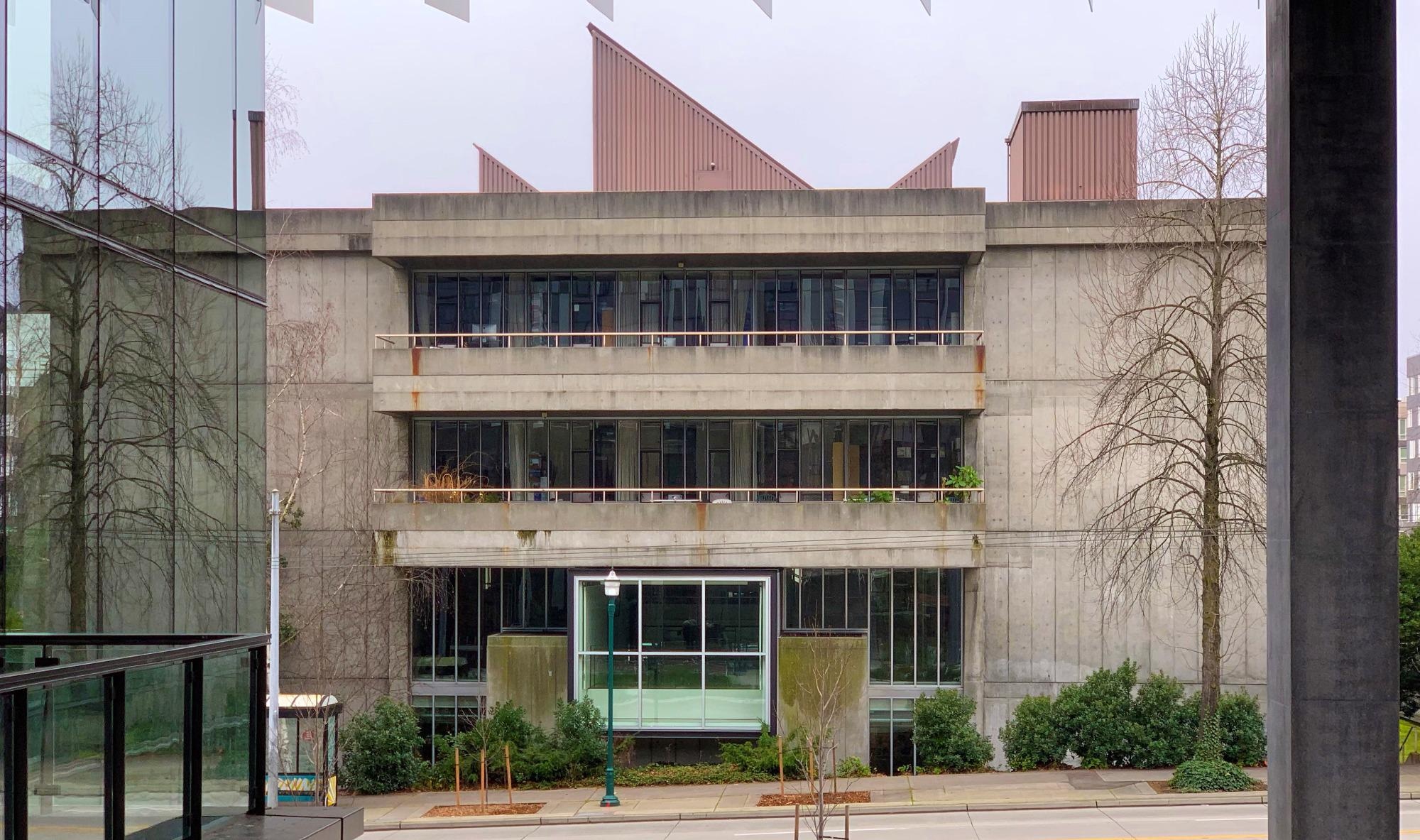
Gould Hall. Image Credit: Alex Anderson
But, in redesigning a simpler building, the architects—Gene Zema, Daniel Streissguth, Grant Hildebrand, and Dale Benedict (all University of Washington Architecture faculty)—made it a powerful essay in concrete. A rather severe, massive exterior opens to a lofty bright interior atrium crossed by dramatic concrete stairs connecting four levels.
Broad wooden handrails on the balconies overlooking the court invite people to rest their elbows and watch the activities in the many rooms that open to the space — a café, a gallery, design studios, offices. It is an excellent building, but I like it best because I interact with it most.
Nearly every day, I walk by its beautifully textured concrete walls, I smell the characteristic scent of concrete in its stairwells, I watch as sunlight slices through the skylights to warm and illuminate the concrete balconies below. Occasionally I head down to the basement to look at its massive air handling system exposed to the view through a huge picture window.
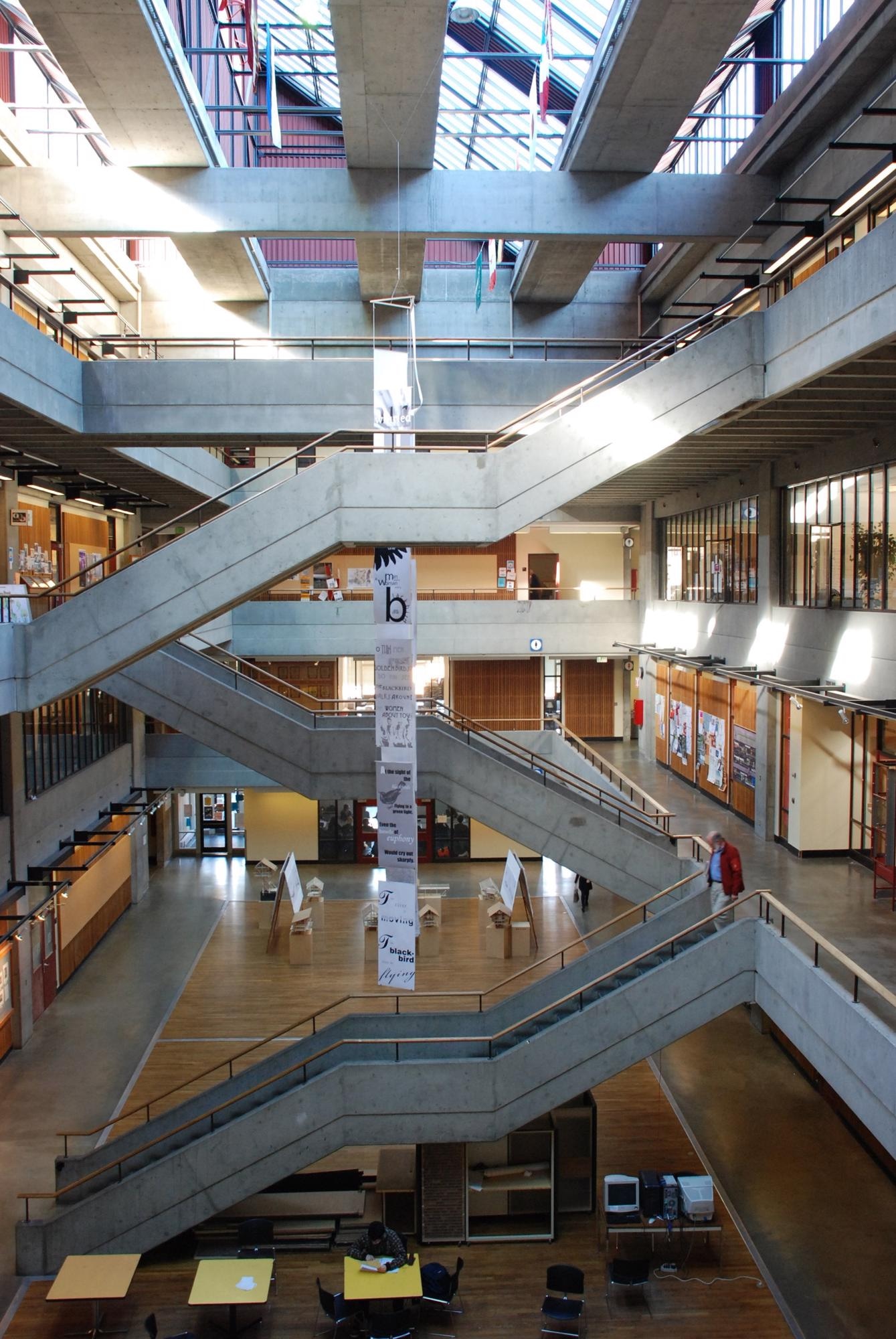
Gould Hall. Image Credit: Alex Anderson
I talk to my colleagues and students about the building often, and most of us seem to agree that the building reveals its qualities more through its subtle, arresting details than in its massive exterior form. This is consistent with the original ethic of Brutalism, which was much more attuned to an idea of truth in materials and connections than to the aesthetics of exterior appearance.
Where can readers find more information?
There are many books about Brutalism. Reyner Banham’s, The New Brutalism: Ethic or Aesthetic? (1966) offers an important account of the beginnings of Brutalism and its early architects and buildings. Phaidon’s 2018 Atlas of Brutalist Architecture, offers an excellent guide to some of the best examples.
The Brutalism Appreciation Society, with more than 150,000 members has an active presence on Facebook, with a seemingly endless supply of photographs and commentary on Brutalist buildings all over the world. My essay on Brutalism and a Harvard studio addressing adaptive re-use of a Brutalist building in Wood’s Hole, Massachusetts, written for Harvard Design News and mentioned in the questions above, is at https://www.gsd.harvard.edu/2019/04/is-redemption-possible-for-the-long-derided-concrete-behemoths-of-brutalism/
About Alex Anderson
 Alex Anderson is Director of the Ph.D. program in the Built Environment and Associate Professor of Architecture at University of Washington, where he teaches courses in architectural design, representation, history, and theory. His research focuses primarily on the relationships between modernism and domestic architecture—specifically early 20th century interior design and decorative arts in Europe, and mid-century factory-based house production in the United States. His book The Problem of the House: French Domestic Life and the Rise of Modern Architecture (University of Washignton Press, 2006) details the work of a group of young designers whose houses and house interiors during the 1910s and 1920s powerfully shaped the direction of modernism in France. His translation of Le Corbusier’s first book, The Decorative Art Movement in Germany, along with an explanatory essay entitled “Learning from the German Machine,” addresses similar developments in early modernism as they unfolded in Germany (Vitra Design Museum, 2008). Dr. Anderson also writes widely on topics in art, architecture, and culture for Harvard Design News (https://www.gsd.harvard.edu/byline/alex-anderson) and Kinfolk magazine (www.kinfolk.com).
Alex Anderson is Director of the Ph.D. program in the Built Environment and Associate Professor of Architecture at University of Washington, where he teaches courses in architectural design, representation, history, and theory. His research focuses primarily on the relationships between modernism and domestic architecture—specifically early 20th century interior design and decorative arts in Europe, and mid-century factory-based house production in the United States. His book The Problem of the House: French Domestic Life and the Rise of Modern Architecture (University of Washignton Press, 2006) details the work of a group of young designers whose houses and house interiors during the 1910s and 1920s powerfully shaped the direction of modernism in France. His translation of Le Corbusier’s first book, The Decorative Art Movement in Germany, along with an explanatory essay entitled “Learning from the German Machine,” addresses similar developments in early modernism as they unfolded in Germany (Vitra Design Museum, 2008). Dr. Anderson also writes widely on topics in art, architecture, and culture for Harvard Design News (https://www.gsd.harvard.edu/byline/alex-anderson) and Kinfolk magazine (www.kinfolk.com).
Disclaimer: The views expressed here are those of the interviewee and do not necessarily represent the views of AZoM.com Limited (T/A) AZoNetwork, the owner and operator of this website. This disclaimer forms part of the Terms and Conditions of use of this website.